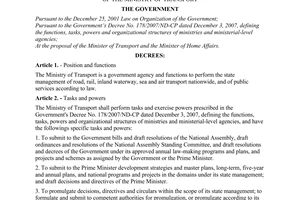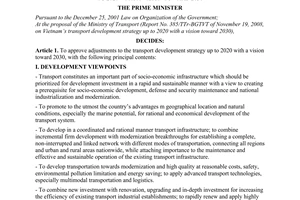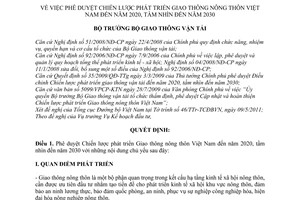Nội dung toàn văn Decision No. 1509/QD-BGTVT approving the strategy on development of Vietnam's
|
THE
MINISTRY OF TRANSPORT |
SOCIALIST
REPUBLIC OF VIET NAM |
|
No. 1509/QD-BGTVT |
Hanoi, July 8, 2011 |
DECISION
APPROVING THE STRATEGY ON DEVELOPMENT OF VIETNAM'S RURAL TRANSPORT THROUGH 2020 WITH A VISION TO 2030
THE MINISTER OF TRANSPORT
Pursuant to the Government's Decree No. 51/2008/ND-CP of April 22, 2008, defining the functions, tasks, powers and organizational structure of the Ministry of Transport;
Pursuant to the Government’s Decree No. 92/2006/ND CP of September 7, 2006, on the formulation, approval and management of socio economic development master plans; and the Government's Decree No. 04/22008/ND-CP of January 11, 2008, amending and supplementing a number of articles of Decree No. 92/2006/ND-CP;
Pursuant to the Prime Minister's Decision No. 35/2009/QD-TTg of March 3, 2009, approving adjustments to the Strategy on transport development through 2020 with a vision to 2030;
Pursuant to the Government Office's Document No. 5099/VPCP-fCTN of July 28, 2009, authorizing the Minister of Transport to appraise, approve, update and finalize the Strategy on development of Vietnam's rural transport:
At the proposal of the Vietnam National Road Administration in Report No. 46/TTr-TCDBVN of May 9, 2011;
At the proposal of the director of the Planning and Investment Department,
DECIDES:
Article 1. To approve the Strategy on development of Vietnam's rural transport through 2020 with a vision to 2030, with the following principal contents:
I. DEVELOPMENT VIEWPOINTS
- Rural transport constitutes an important part of rural socio-economic infrastructure. Investment in rural transport should be prioritized to create a prerequisite for socio-economic development in rural areas, assure food security, and maintain defense and security for agricultural and rural industrialization and modernization.
- To develop rural transport in conformity with local socio-economic and transport development strategies and master plans well as the national target program on building a new countryside: to develop rural transport in a sustainable manner, creating smooth linkage between the national road network and provincial, district, commune and village roads and between large specialized commodity production zones, material zones and processing industrial complexes, between production, processing and consumption, combining economic, defense and security activities, with a view to better satisfying national economic development requirements and people's travel needs.
- To bring into play geographical advantages and natural conditions of each region for rural transport development, combining road and waterway transport, transport and irrigation, agriculture, forestry and other economic sectors in localities.
- To adopt policies to prioritize rural transport development in high mountainous, deep-lying, remote and border areas which are important in defense and security maintenance in order to boost development and narrow the gap between regions and areas.
- To adopt mechanisms and policies for rational and effective administration and maintenance of the rural transport system with the participation of administrations at all levels and people.
- To mobilize to the utmost all resources for rural transport development, from central and local budgets, the population, international donors and organizations and individuals at home and abroad.
- To actively apply sciences and techniques, use new materials, local materials and simple and easy-to-apply construction technologies which the majority of people can manage and use by themselves under technical instructions.
- To operate different modes of passenger and goods transportation and vehicles suitable to local conditions with a view to facilitating goods and passenger transportation in rural areas.
- To reserve rational land areas for developing rural transport infrastructure works, assuring traffic safety corridors and protecting the environment.
II. RURAL TRANSPORT DEVELOPMENT STRATEGY THROUGH 2020 WITH A VISION TO 2030
1. Development objectives through 2020
a/ Transportation
- To provide convenient mass transit services from district to commune centers, facilitating travel for farmers living in rural areas and reducing personal motor vehicles.
b/ Infrastructure works
- Roads:
+ By 2015, 100% of communes will have car-accessible roads to commune centers, excluding communes facing extreme topographical difficulties and too high investment expenses where already exist roads accessible to motorbikes and rudimentary vehicles; in communes on islets and islands, ferry stages and wharves must be built for connection to commune centers.
+ 100% of district and commune roads will be accessible all year round; 100% of district roads and at least 70% of commune roads will be asphalted or concreted.
+ To gradually upgrade rural roads to technical grades, district roads at least to grade V and commune roads at least to grade VI according to Vietnam standard TCVN 4054:2005.
+ At least 50% of village and hamlet roads will he concreted to grade A according to standard 22 TCN 210-92.
+ At least 45% of inner-field main roads will be concreted to facilitate motor vehicles' operation.
+ To step by step build permanent bridges and sluices along rural roads: to abolish rudimentary bridges, especially in the Mekong River delta.
+ To develop inner-field roads to meet the demand for industrialization of production, harvesting, processing and sale of agricultural products and mechanization of agricultural production.
To step by step allocate funds for maintaining rural roads: 100% of district roads and at least 45% of commune roads.
- Waterways:
+ To upgrade and renovate transport inland waterways with irrigation systems.
+ To step by step build wharves and river ports (by 2020, there will be one port or wharf per commune on average) in areas where passenger and goods transportation by river can be used to serve agriculture and rural areas, especially in the Red River and Mekong River deltas.
2. Vision to 2030
To further organize and improve transportation services from district to commune centers lo meet travel and development needs in rural areas.
To basically complete the rural transport infrastructure network, 100% of district and commune roads will be upgraded to technical grades, asphalted or concreted and maintained under plans: 100% of village and hamlet roads will be concreted at least to grade A according to standard 22 TCN 210-92. To further develop and improve inner-field transport quality.
3. Development strategy through 2020
a/ Transportation
+ To develop kinds of vehicles suitable to topographical conditions and transport infrastructure works and meeting travel needs of rural people.
+ 100% of districts will have bus stations in district centers at least up lo grade 4. To arrange car stops in commune centers located along national highways as well as provincial and district roads with mass transit routes.
+ 100% of districts will have wharves and storing yards for agricultural commodities.
+ To organize vehicle repair service points in district centers.
b/ Region-based infrastructure development
Northern mountainous midland areas
- Roads:
+ By 2015, 100% of communes will have car-accessible roads to commune centers, excluding communes facing extreme topographical difficulties and too high investment expenses where already exist roads accessible to motorbikes and rudimentary vehicles.
+ 100% of district roads and at least 70% of commune roads will be asphalted or concreted at least to grade V, for district roads, and at least to grade VI, for commune roads.
+ Solid bridges and sluices along district and commune roads will be built corresponding to planned road grades.
+ At least 35% of village and hamlet roads will be concreted at least to grade A.
+ At least 35% of inner-field main roads will be concreted to facilitate motor vehicles' operation.
+ To step by step allocate funds for maintaining rural roads: 100% of district roads and at least 35% of commune roads.
- Riverways:
+ To renovate navigable channels for transportation; to attach importance to building wharves and ports to ensure effective and safe navigation.
Red River delta
- Roads:
+ 100% of district and commune roads will be asphalted or concreted at least to grade IV, for district roads, and grade VT, for commune roads.
+ Solid bridges and sluices along district and commune roads will be built corresponding to planned road grades.
+ At least 70% of village and hamlet roads will be concreted at least to grade A.
+ At least 70% of inner-field main roads will be concreted to facilitate motor vehicles' operation.
+ To step by step allocate funds for maintaining rural roads: 100% of district roads and at least 55% of commune roads.
- Riverways:
+ To upgrade and renovate a number of locally managed main riverways for craft of 50-100 tons to operate.
+ To renovate locally managed riverways for craft of under 10 tons to operate.
+ To build wharves and ports to ensure effective and safe navigation.
Northern central and coastal central region
- Roads:
+ By 2015, 100% of communes will have car-accessible roads to commune centers, excluding communes facing extreme topographical difficulties and too high investment expenses where already exist roads accessible to motorbikes and rudimentary vehicles.
+ 100% of district roads and at least 70% of commune roads will be asphalted or concreted at least to grade V. for district roads, and at least to grade VI, for commune roads.
+ Solid bridges and sluices along district and commune roads will be built corresponding to planned road grades.
+ At least 50% of village and hamlet roads will be concreted at least to grade A.
+ At least 50% of inner-field main roads will be concreted to facilitate motor vehicles' operation.
+ To step by step allocate funds for maintaining rural roads: 100% of district roads and at least 45% of commune roads.
- Riverways:
+ To upgrade navigable channels for transportation; to attach importance to building wharves and ports to ensure effective and safe navigation.
Central Highlands region
- Roads:
+ By 2015, 100% of communes will have car-accessible roads to commune centers.
+ 100% of district roads and at least 70% of commune roads will be asphalted or concreted at least to grade V, for district roads, and at least lo grade VI, for commune roads.
+ Solid bridges and sluices along district and commune roads will be built corresponding to planned road grades.
+ At least 50% of village and hamlet roads will be concreted at least to grade A.
+ At least 50% of inner-field main roads w ill be concreted to facilitate motor vehicles operation.
+ To step by step allocate funds for maintaining rural roads: 100% of district roads and at least 40% of commune roads.
- Riverways:
+ To renovate navigable channels for transportation; to attach importance to building wharves and ports to ensure effective and safe navigation.
Southeastern region
- Roads:
+ 100% of district roads and commune roads will be asphalted or concreted at least to grade IV, for district roads, and grade VI, for commune roads.
+ Solid bridges and sluices along district and commune roads will be built corresponding to planned road grades.
+ At least 70% of village and hamlet roads will be concreted at least to grade A.
+ At least 70% of local main roads will be concreted to facilitate motor vehicles" operation.
+ To step by step allocate funds for maintaining rural roads: 100% of district roads and al least 45% of commune roads.
- Riverways:
+ To upgrade navigable channels for transportation; to attach importance to building wharves and ports to ensure effective and safe navigation.
Mekong River delta region - Roads:
+ By 2015, 100% of communes will have car-accessible roads to commune centers, except island communes where ferry stages must be built because road bridges cannot be built yet.
+ 100% of district roads and at least 70% of commune roads will be asphalted or concreted at least to grade V, for district roads, and at least to grade VI, for commune roads.
+ Solid bridges and sluices along district and commune roads will be built corresponding to planned road grades.
+ At least 35% of village and hamlet roads will be concreted at least to grade A.
+ At least 35% of local main roads will be concreted to facilitate motor vehicles' operation.
+ To step by step allocate funds for maintaining rural roads: 100% of district roads and at least 50% of commune roads.
+ To abolish all rudimentary bridges.
- Riverways:
+To renovate and dredge navigable channels and step by step install safety systems to ensure effective and safe navigation.
+ To build wharves and ports for ships of enterprises, households and island communes.
III. MAJOR SOLUTIONS AND POLICIES FOR RURAL TRANSPORT DEVELOPMENT
1. State management solutions and policies
To develop rural transport according to strategies, master plans and plans. Based on approved strategies for rural transport development nationwide and in economic zones, local administrations (at provincial, district and commune levels) shall, according to their functions, tasks and powers, elaborate and implement rural development master plans and plans in their localities.
To enhance rural transport management capacity from central to local levels, especially at district and commune levels; to raise managerial capacity in both managerial and technical knowledge for district and commune officials.
2. Solutions and policies to raise capital for rural transport development
To mobilize all domestic and foreign resources from different economic sectors in different forms, such as slate budget, government bonds and rural development and construction investment projects and programs, people's and community's contributions in cash, supplies and labor, for rural transport development.
3. Scientific and technological solutions and policies
To use locally available materials, attaching importance to using new materials and applying new technologies and technical standards suitable to each region's specific conditions, for rural transport construction and development.
4. Maintenance solutions and policies
To clearly define responsibilities and assign tasks for rural transport administration and maintenance between local administrations at all levels (provincial, district and commune levels); to raise awareness and form a habit for rural transport administration and maintenance.
To issue specific regulations on rural transport administration and maintenance.
5. Human resource development solutions and policies
To increase capacity and quantity of officers who directly manage rural transport: to formulate annual training programs for rural transport managers at all levels.
To adopt policies on salaries and preferences for laborers working in specific conditions, especially in rural transport administration and maintenance in deep-lying, remote and difficult-travel areas.
6. Traffic safety solutions and policies
To improve the legal system and strengthen traffic safety management in localities. To improve propagation, dissemination and education work in combination with enhancing enforcement of the law on traffic order and safety.
To develop (he rural transport infrastructure system to assure traffic safety and road safety corridors.
To improve the quality of driver training, testing and management and the quality of inspection and management of motor vehicles in rural areas.
To increase rescue and salvage activities to reduce damage caused by traffic accidents.
7. Environmental protection solutions and policies
To improve standards, guidelines and regulations on environmental protection in building and operating transport works and in transportation. To increase propagation. dissemination and education work and enforcement of the environmental protection law.
To raise the quality of environmental protection supervision and management. To conduct strategic environmental assessment from the stage of planning, and environmental impact assessment from the stage of project formulation. To closely supervise implementation of environmental protection regulations under projects to build transport industrial works and establishments in rural areas with a view to reducing adverse impacts on the environment.
Rural transport works and vehicles operating in rural areas must comply with technical and quality standards meeting environmental protection requirements.
8. Solutions and policies to encourage all economic sectors to join in rural transport development
To adopt mechanisms and policies to encourage all economic sectors, subcontractors and individuals to join in building, administering and maintaining rural transport works and providing services in rural areas.
Article 2. Organization of implementation
1. The Ministry of Transport shall assume the prime responsibility for, and coordinate with ministries, sectors and provincial-level People's Committees in, publicizing the Strategy on rural transport development through 2020 with a vision to 2030; and regularly update and adjust this Strategy to meet national socio-economic development requirements.
2. Based on the Strategy, provincial-level People's Committees shall direct the formulation and implementation of their local master plans on rural transport development in line with this Strategy; and annually report implementation results to the Ministry of Transport and concerned ministries.
Article 3. This Decision takes effect 45 days from the date of its signing.
Article 4. Ministers, heads of ministerial-level agencies, heads of government-attached agencies and chairpersons of provincial-level People's Committees shall implement this Decision.-
|
|
MINISTER
OF TRANSPORT |


